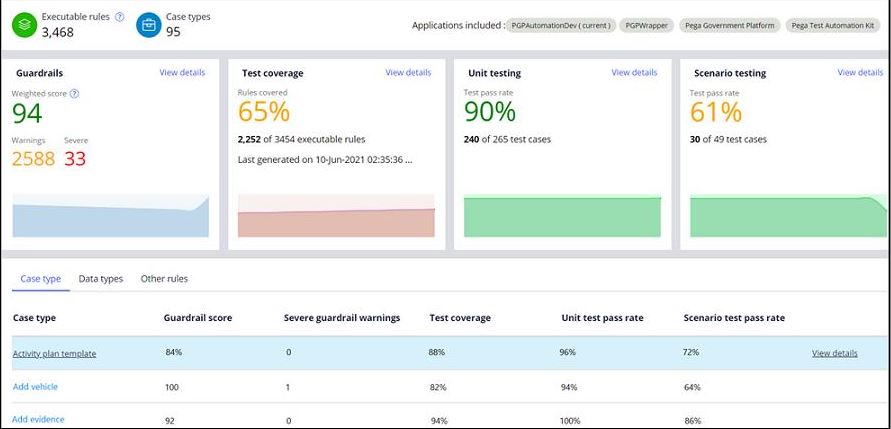Pega Express best practice DevOps, testing, and guardrails
The best practices of DevOps, testing and guardrails work together to improve application quality and stability. The details below describe how our Pega Express Delivery™ approach combines the disciplines into one best practice to create an integrated approach to manage application quality and stability.
When development and operations teams come together, they reduce lead time, deploy more frequently, and produce higher-quality software. (Atlassian)
What is DevOps, testing, and guardrails?
At Pega, our Pega Express™ delivery approach consolidates the three disciplines of DevOps, testing, and guardrails into a single best practice for the management of application quality and stability as you iteratively release increasing numbers of capabilities into your production-ready applications. Together, these three disciplines work to create a powerful package of integrated processes and tools that deliver high-quality working solutions in the simplest, fastest and most efficient way possible.
- Application Testing - Our approach to application testing is based on the tenets of test early, test often, and automate as much as possible. The Pega Express™ delivery approach provides for all levels of testing, from Unit testing to end-to-end user acceptance testing, along with performance and security testing.
- Guardrails - Guardrails help guide development teams to achieve the highest project success, and include optimal reuse, maintainability, and system performance. Guardrails help determine which elements in the application do not comply with Pega technical quality best practices, and enable teams to rectify any issues early on.
- DevOps - The goal of DevOps is to deploy an application into a production environment faster, gathering feedback to rapidly enhance the product. It allows application developers and business owners to quickly respond to customer needs, increase the feedback cycle, and achieve business value faster. Pega Platform™ offers tools to support continuous integration, delivery, and deployment through Deployment Manager. Deployment manager provides a low-code, model-driven experience to configure and run continuous integration and continuous delivery workflows or deployment pipelines for your application.
Why does DevOps, testing, and guardrails add value?
The integrated disciplines supported by these tools and processes ensure that from the very start of your project, all the way through to Go-live and beyond, the integrity and quality of the technical delivery is maintained. The goal is to deliver a high-quality working system in the simplest, most efficient way possible. Improved testing ensures that the solution you create, build, and deliver is one that your client loves.
Speed is everything. Teams that practice DevOps release deliverables more frequently, with higher quality and stability. (Atlassian)
When does DevOps, testing, and guardrails take place?
The concepts of DevOps, testing and guardrails are key to our delivery success and each plays a role at various points during the project delivery lifecycle.
Typically, the foundation to support DevOps should be established early on, as the project is preparing to build and test the application. It's at this time that the application stack should be established to support automated testing, which is so critical to DevOps, along with working practices that support sprint testing and daily releases.
During the iterative build cycle, verification of the application will span the range of testing types. For each incremental sprint release, the DevOps process should be automating the regression testing and deployment of updated code. Whilst the DevOps process is in place, the Lead System Architect (LSA) uses the Application Dashboard to constantly monitor compliance with guardrails and application quality, to maintain the highest possible standards.
Below is a screenshot which shows the contents of the Application Dashboard. The Application Dashboard presents the LSA with the summary results for the guardrail and testing scores.

Using the Application Dashboard, the LSA can drilldown to the detailed information for each summary score and address any issues where scores are lower that recommended.
Previous topic Pega Express best practice Scrum Next topic Pega Express best practice Solution documentation
